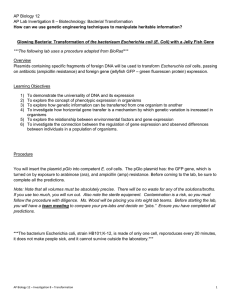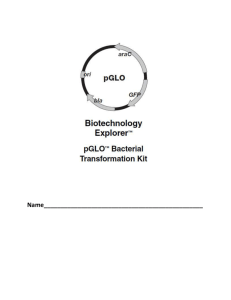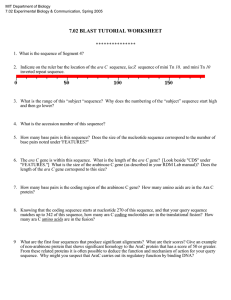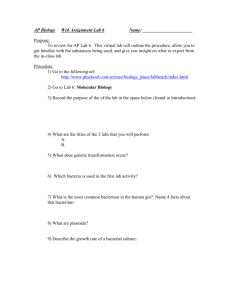AP Biology 12 – Biotechnology: Bacterial Transformation AP Lab Invertigation 8
advertisement
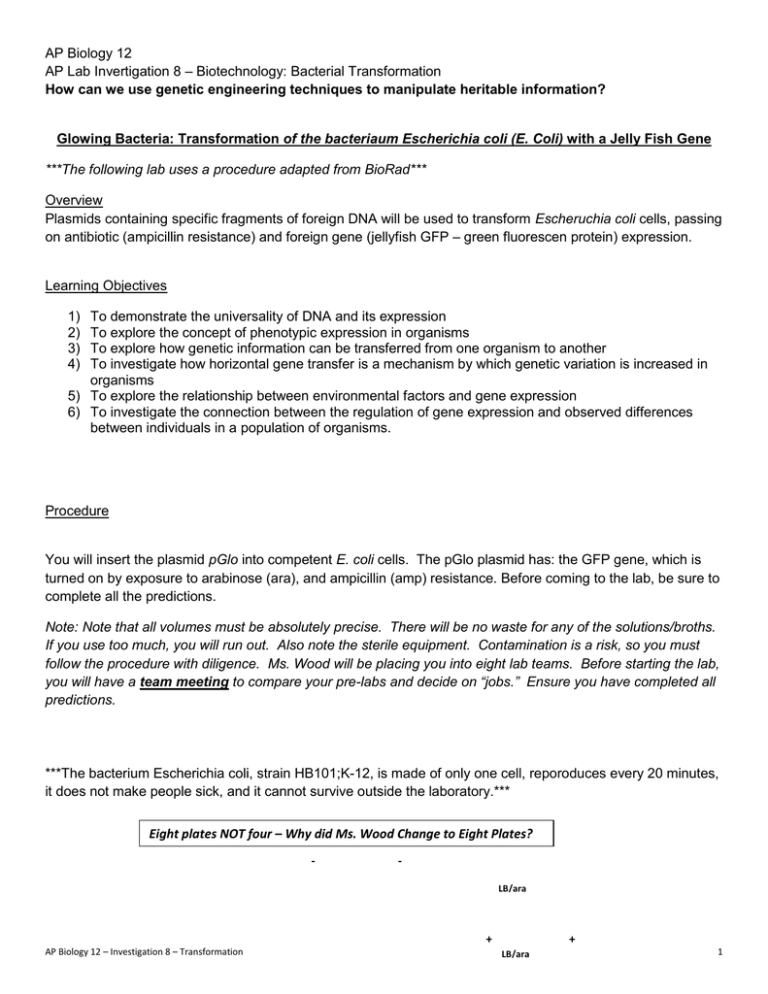
AP Biology 12 AP Lab Invertigation 8 – Biotechnology: Bacterial Transformation How can we use genetic engineering techniques to manipulate heritable information? Glowing Bacteria: Transformation of the bacteriaum Escherichia coli (E. Coli) with a Jelly Fish Gene ***The following lab uses a procedure adapted from BioRad*** Overview Plasmids containing specific fragments of foreign DNA will be used to transform Escheruchia coli cells, passing on antibiotic (ampicillin resistance) and foreign gene (jellyfish GFP – green fluorescen protein) expression. Learning Objectives 1) 2) 3) 4) To demonstrate the universality of DNA and its expression To explore the concept of phenotypic expression in organisms To explore how genetic information can be transferred from one organism to another To investigate how horizontal gene transfer is a mechanism by which genetic variation is increased in organisms 5) To explore the relationship between environmental factors and gene expression 6) To investigate the connection between the regulation of gene expression and observed differences between individuals in a population of organisms. Procedure You will insert the plasmid pGlo into competent E. coli cells. The pGlo plasmid has: the GFP gene, which is turned on by exposure to arabinose (ara), and ampicillin (amp) resistance. Before coming to the lab, be sure to complete all the predictions. Note: Note that all volumes must be absolutely precise. There will be no waste for any of the solutions/broths. If you use too much, you will run out. Also note the sterile equipment. Contamination is a risk, so you must follow the procedure with diligence. Ms. Wood will be placing you into eight lab teams. Before starting the lab, you will have a team meeting to compare your pre-labs and decide on “jobs.” Ensure you have completed all predictions. ***The bacterium Escherichia coli, strain HB101;K-12, is made of only one cell, reporoduces every 20 minutes, it does not make people sick, and it cannot survive outside the laboratory.*** Eight plates NOT four – Why did Ms. Wood Change to Eight Plates? - LB/ara + AP Biology 12 – Investigation 8 – Transformation + LB/ara 1 Day 2 1) Remove your plates from the incubator. 2) Count the number of colonies growing on each plate and record the value in the results; use a permanent marker to mark each colony on the bottom of the plate (not the lid) as it is counted. If the cell growth is too dense to count individual colonies, record “lawn.” Do not open the plates for counting! 3) Take into a dark area (W203A) and observe any glowing under UV light! Wear the UV goggles. 4) Compare results to predictions. 5) What does each plate tell you about the experiment? AP Biology 12 – Investigation 8 – Transformation 2 Table 1. Predictions Plate Predictions Colony Growth? #colonies/lawn/none Glowing Red Fluorescent Protein? Yes/No LB+ LBLB/Amp+ LB/AmpLB/Ara+ LB/AraLB/Amp/Ara+ LB/Amp/Ara- Table 2. Results Plate Actual Results Colony Growth? #colonies/lawn/none Glowing? Yes/No LB+ LBLB/Amp+ LB/AmpLB/Ara+ LB/AraLB/Amp/Ara+ LB/Amp/AraOther Observations and Experimental Notes: AP Biology 12 – Investigation 8 – Transformation 3 Analysis of Results What does each plate tell you about the experiment? How do your results compare to your predictions? How do your results compare with other lab teams? What is the significance of what you just did? Conclusion Refer to the criteria on the lab rubric. Beginning Developing Accomplished Exemplary o Point form o Poor sentence structure (fragments) o Full sentences o o Purpose and/or results not referred to o Refers to purpose, summarizes results without insight o Answers purpose by summarizing results o o No sources of error o Sources of error not relevant o States 1-2 relevant sources of error o o No connection to relevance o Relevance attempted, but invalid o Reveals relevance of results o o Clear communication through structured sentences that connect one idea to the next Answers purpose by comparing key results to predictions/hypothesis (supported/ rejected/inconclusive) States 2 or more insightful sources of error and suggests improvement to this lab Connects to big picture (relevance) Asks new questions and suggests new experiments for the future Further comments/suggestions: AP Biology 12 – Investigation 8 – Transformation 4
